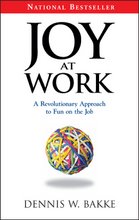Many of the attitudes that took hold during the Industrial Revolution linger on today, a circumstance brought to my attention by author Bob Waterman, who in our early days at AES had walked us through his Seven-S framework. “Based on what you know about the workplace and organizational arrangements of those businesses operating several hundred years ago, what were the assumptions made by the owner/managers about the workers who labored in their factories?” he asked.
I have asked that same question hundreds of times of people in my company, students in colleges and graduate schools, government employees, and leaders in many other organizations. Here is a summary of their responses:
- Workers are lazy. If they are not watched, they will not work diligently.
- Workers work primarily for money. They will do what it takes to make as much money as possible.
- Workers put their own interests ahead of what is best for the organization. They are selfish.
- Workers perform best and are most effective if they have one simple, repeatable task to accomplish.
- Workers are not capable of making good decisions about important matters that affect the economic performance of the company. Bosses are good at making these decisions.
- Workers do not want to be responsible for their actions or for decisions that affect the performance of the organization.
- Workers need care and protection just as children need the care of their parents.
- Workers should be compensated by the hour or by the number of “pieces” produced. Bosses should be paid a salary and possibly receive bonuses and stock.
- Workers are like interchangeable parts of machines. One “good” worker is pretty much the same as any other “good” worker.
- Workers need to be told what to do, when to do it, and how to do it. Bosses need to hold them accountable.
These assumptions have had a profound effect on personnel arrangements and decision-making structures in large businesses, governments, schools, and other large organizations.
Specialization became the rule. Lines of authority were clear. Workers were told exactly what was expected of them. A curious arrangement of staff and line positions emerged (experts suggest that the Prussian Army was the first to use this approach, late in the 19th century). The paternalistic impulse led to the creation of “benefits” that were provided in lieu of cash (free or cut-rate housing, schooling, and medical care). Most of the systems, controls, compensation criteria, and decision-making and leadership styles that we find in organizations today can be traced to these beliefs about workers.
When I ask people whether they believe the assumptions listed above still apply to modern-day working people, especially in the Western world, almost everyone says no. Most would agree with Max De Pree, a manufacturing executive who was a pioneer in participatory management, that advanced countries are entering a period in which 80 percent of workers will make their living by brainpower.
However, based on my own observations, I suspect that many corporate leaders still hold some Industrial Revolution views. What’s more, many of the approaches and practices in modern workplaces are nearly as demeaning as those used during the Industrial Revolution. Executives are either oblivious to the similarities—or won’t admit them. These are the only plausible explanations for the relative lack of change over 250 years in the structure of work in modern corporations, government agencies, and nonprofit organizations.
In my experience, most people don’t believe that fun and work can coexist. In large organizations, so few executives have experienced a joyful workplace that they have no idea how to create one. The result: Most employees grasp for high pay and benefits, fewer hours on the job, the mindless comfort of routine, less responsibility, early retirement, and job security. All are hollow substitutes for a rewarding, stimulating workplace. If you’re lucky, the workplace created by the Industrial Revolution may put food on the table, pay for your kids’ schooling, and even provide for a comfortable retirement. But “where’s the love, man?” as the old Bud Light commercial asked. Where is the love for work and accomplishment? Where are the other unique traits and gifts and frailties that make us human? Where is the passion to serve?
Maybe these were lost in the race for productivity and profits. I believe, however, that nothing so fundamental to human nature can be lost forever. If that is true, it will transcend even a movement as powerful as industrialization. It remains alive in many of our homes. It is preached in our churches, synagogues, and mosques. It exists in our memories of teamwork and competition in gyms and on playing fields. I am confident that it cannot be long absent from the place where we spend most of our waking hours—at work.

